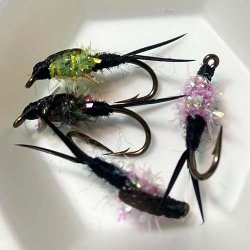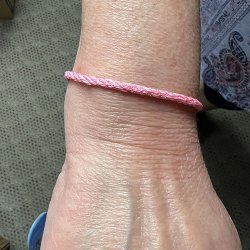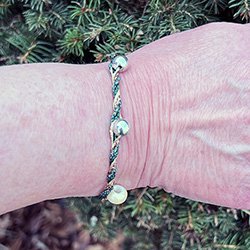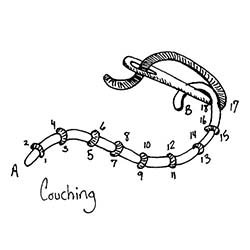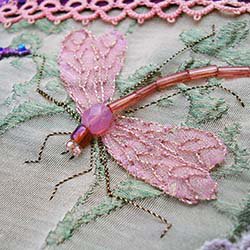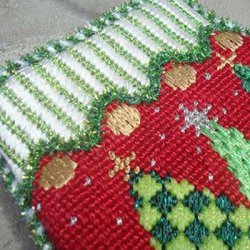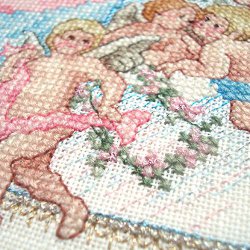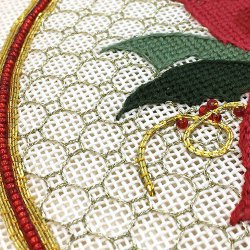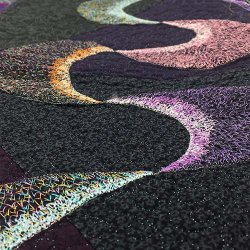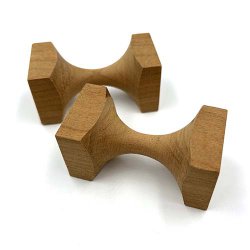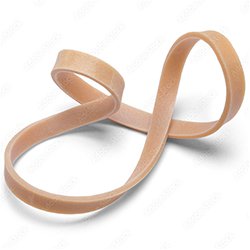- Shop Fly Fishing
-
Shop Needlework
- Metallic Threads
- Silk Threads
- Kits & Sets
- Accessories
- Free Patterns
- How To
23 products found
Sort by:
Recommended
Shop Fly Fishing > Tying With Kreinik
-
How to use Micro Ice Chenille
Kreinik Micro Ice Chenille is the perfect metallic chenille for bodies on any size lure. Wrap once, twice, or as many times as desired. Combine it with Kreinik Braids, Ribbons and Flash for the most effective fly fishing lures you'll ever use. Experiment and have fun with this fiber.
Watch fly tyer Val Roberts using Kreinik Micro Ice Chenille (the pink) and Kreinik Flash (the red) to make a body on this scud-like fly. In addition to the metallic shimmer and fuzzy texture, the pink chenille has some UV properties.
Here Val uses Micro Ice Chenille to replicate a catepillar:
Shop Needlework > Accessories > Custom Corder
-
How to make a pink friendship bracelet
Pink is more popular than ever, thanks to a certain movie out in the summer of 2023. Here's how to make your own friendship bracelets using pink shades of Kreinik metallic threads. Gather your friends for a DIY craft party celebrating both the movie and friendship.
Shop Needlework > How To > Custom Corder
-
How to cord a long purse strap
The Custom Corder is a great tool for making custom piping: combine any fiber, in any color, to be any thickness. The length of your needed piping determines how much thread goes into it: you take your piping length and multiply it times 3, and that's how long each fiber in your trim needs to be. What about if you want to make a purse strap? Three times the length of a purse strap sounds like a really long length of fiber. Watch our video below to see how we made one for a Melissa Prince needlepoint canvas purse.
-
How to make beaded friendship bracelets
Watch Doug Kreinik show you how to add beads to cording while making friendship bracelets with the Kreinik Custom Corder:
Shop Needlework > How To > Library Of Stitches
-
Couching
Where to use it:
In cross stitch, needlepoint, surface embroidery and counted thread designs where you want to attach a real metal thread, or a larger item like a thick thread or cording, and in traditional Japanese embroidery.
What to couch:- Kreinik 1/8" Ribbon & 1/16" Ribbon
- Kreinik Heavy #32 Braid, Canvas #24 Braid & Medium #16 Braid
- Kreinik Japan #5 & Japan #7
- Kreinik Japan colors in #16 Braid, 1/16" Ribbon, and 1/8" Ribbon
- Kreinik Torsade
- Kreinik real metal threads
- Kreinik Facets & Petite Facets
Use these finer threads to couch the thicker ones:
- Kreinik Cord
- Kreinik Japan #1
- Kreinik Silk Bella
- Kreinik Silk Couching Thread
How to do it:
Follow the diagram for needle and stitch placement. Plunge the end of your thicker thread into the fabric at A, securing the ends on the back of your fabric with a few stitches, or temporarily taping the end. To couch, come up at 1, down at 2, up at 3, down at 4, etc. When finished, plunge the end into the fabric at B, and secure end on the back of your fabric with a few stitches.
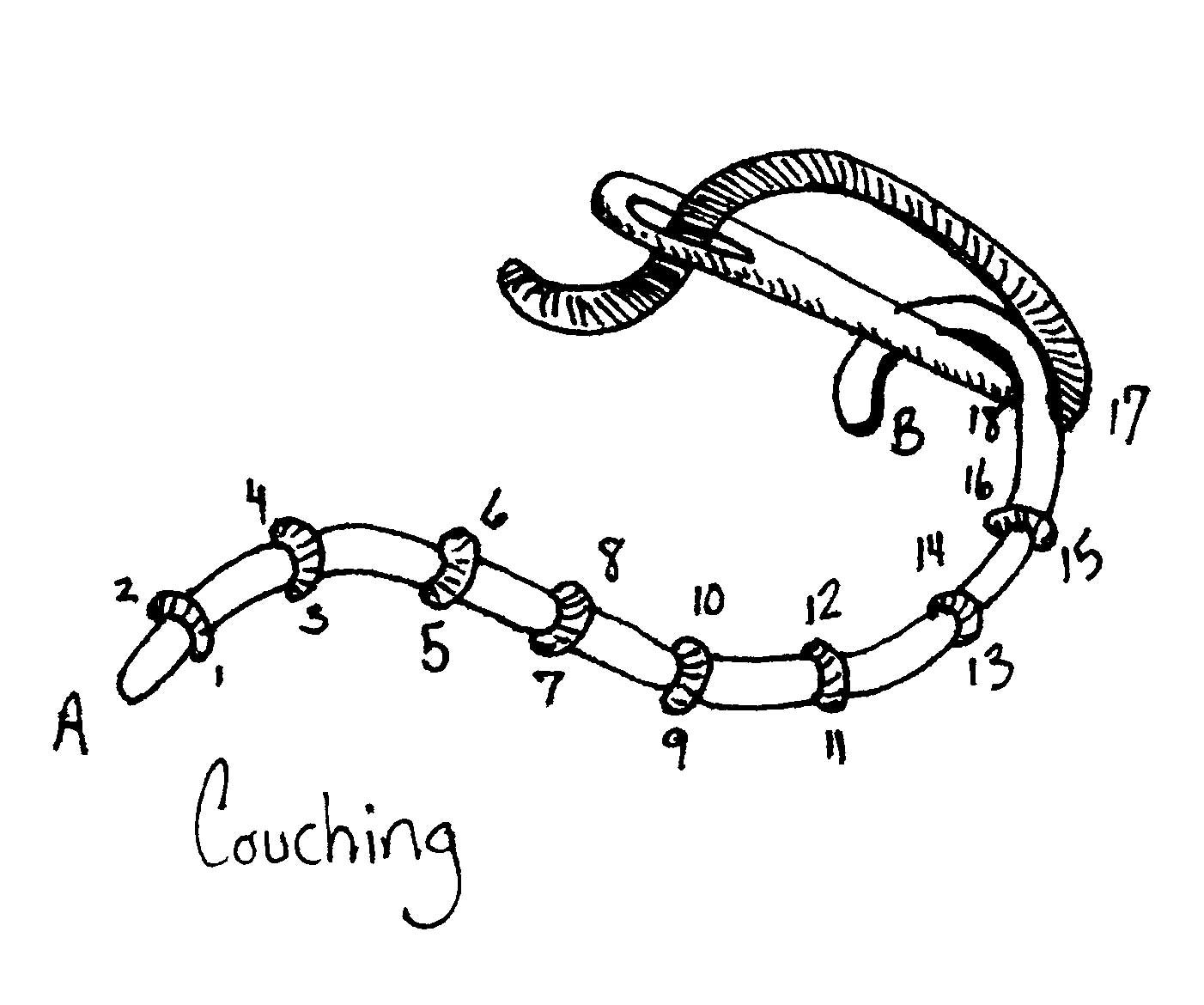
Alternative:
Designer and teacher Anna-Marie Winter taught us that you can also couch a thicker thread by inserting your tacking stitches down the center of the larger thread, rather than side-to-side as in the traditional instructions above. This enables you do make curves and corners more easily.
WATCH how to couch in needlepoint:
Shop Needlework > How To > Metallic Thread
-
How to use metallics in crazy quilting
By Pat Winter, crazy quilt artist, designer and writer
I am a crazy quilter and I prefer Kreinik Metallic thread for my hand stitched seam treatments. Not only does Kreinik come in a variety of thicknesses, but the color assortment is amazing and fits all my designing needs. The ”vintage” colors are superb and among my favorite because I love to work in Victorian colors.
I first used Kreinik threads over 20 years ago when I combined it with my cotton floss in my cross stitch projects. The sparkle really made the piece come alive. I now use Kreinik metallic threads for my embroidery stitches in my crazy quilt items. Metallic threads make simple stitches stand out.
Is there a difference in thread?
I have tried various metallic threads as I would find them while browsing a quilt booth or new shop thinking they are all the same. I was surprised to find most of them frustrating to work with. They would break with very little pressure, and fray. I always use a sharp needle with a large eye when I hand sew with metallic threads so I was not adding stress by pulling thread through a tight fabric. I use every fabric imaginable in my crazy quilting and I can always depend on Kreinik threads to do the job with ease and no breakage.
Which thread for which design?
In most of my seams I prefer to use Very Fine # 4 braid and Fine #8 braid because it allows me to create small close stitches which I can add several combination stitches with by adding more colors to coordinate with the fabrics I used in the project. This makes a much more interesting seam in Fig. A.
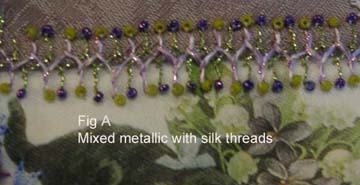
I use Blending Filament to outline a printed image or add it to a silk thread for a sparkle in fig. B.
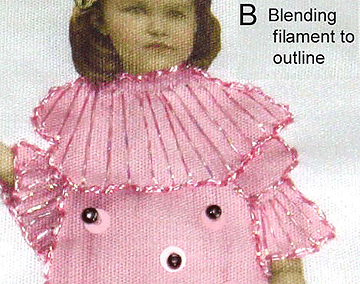
Cord is great for spider webs and legs of a beaded spider or insect. I also use it for the feather stitch down each dragonfly wing for great detail in fig. C.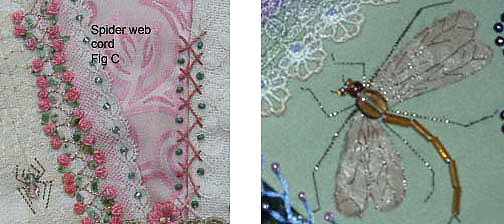
Larger seams call for larger threads. For these I use 1/16" Ribbon or Medium #16 Braid in fig. D.
Helpful hints when using metallic threads for hand stitching:
1. Always use a sharp needle with a large eye for smooth sewing and no tugging through fabrics.
2. Unwind a length of 18 inches and pull it through your fingers to unwind before you begin to sew. This relaxes it and it won't wind up on you.
3. I have never had Kreinik metallic thread tangle on me, but if you find this happening, run it through Thread Heaven, a light silicon lubricant or bees wax. -
How To Use Kreinik Micro Ice Chenille
Quick! Name five things that are fuzzy (bonus points for fuzzy metallic things). How about: garland on Christmas trees, legs on spiders, flower centers, bushy eyebrows, other, ahem, hairy things, peaches, caterpillars, lots of bugs actually, baby chicks, moldy cheese, your brain after a long weekend. How many could you list? Nature and life itself are full of texture. It makes things visually interesting and tactile.
You can recreate the fuzzy factor of true life objects with Kreinik's Micro Ice Chenille in your favorite hobby: needlepoint, cross stitch, embroidery, fly fishing, crochet, knitting, weaving. It adds whimsy, dimension, texture, and just plain visual interest to a design.What is Micro Ice Chenille and where can you use it?
- it's a fuzzy metallic
- couch in needlepoint, cross stitch, quilting, crazy quilting for surface embroidery (couch it with a Kreinik Cord or Very Fine #4 Braid, rather than stitch in and out)
- can also use it in long stitches in needlepoint if the canvas is not densely stitched (Micro Ice Chenille just doesn't like going in and out of fabric very much)
- combine it with any other fiber for cording and trims on stockings, ornaments, etc
- crochet little accessories and appliques (wreaths, flowers)
- use it in duplicate stitch in knitting (like a spider!)
To use in weaving:
- Can be used in weft, not for warp (too much stress)
- Weight/Yardage: Kreinik metallic yarns are not measured in terms of weight like wool or cotton yarns are, so measure by yard or meter. Purchase 50-meter cones; or cones of any amount by special order.
- Sett = 5 epi
- Care: Kreinik metallics don't felt, and are inelastic compared to some other types of yarns, so for best results, we recommend testing the threads with the weaving yarns you plan to use before beginning your project.
- Tips from weaver Deb Essen of DJE Handwovens: 1. Pull the thread off the cone horizontally, not from the top, to avoid adding twist to the fiber. 2. Combine with other yarns (rather than use a metallic exclusively) as an accent yarn for best results ("It makes a great, fun fabric"). 3. Test how the textures work together before making your main project: make test swatches if using stretchy yarns with the inelastic metallics, for instance, then use a warm-water wash for the wet-finishing. 4. You may want to experiment with looser sett to vary drapability. 5. Play! Have fun! "I love how the colors pop in sunlight or lamplight and shimmer as the piece is moved."
Content:
Cotton core, polyester metallic
-
How to use Blending Filament
Applications:
Blackwork, crewel, crochet, cross stitch/counted thread, doll making (by hand and machine), fly fishing, hardanger, knitting (by hand), lace making, machine embroidery/bobbin work, machine embroidery/in the needle, miniatures, needlepoint/canvas work, punch embroidery, silk gauze/Polysil embroidery, smocking, stumpwork, weaving, and many more.
Hand Embroidery:
The thin quality of Blending Filament allows you to create elements of subtle light reflection. It is often combined with cotton, wool or another thread type, in the same needle, to create a random metallic sparkle. The addition of one or two strands does not add weight to your thread, so you can use the needle size that accommodates the stranded cotton. Vary the amount of highlight or shimmer you want to add to a design by using one or more strands; use a single strand for the most subtlety or two strands for added effect.
Overstitching & Texture:There's more to Blending Filament than just 'blending,' however. You can also use Blending Filament by itself to overstitch, bringing a reflective highlight or glow to a particular spot. Also, use a single strand of Blending Filament by itself in half-cross stitches for backgrounds on fabric; it creates a slight texture and subtle shimmer.
Tips on using Kreinik Blending Filament in hand work:
- Use short lengths of thread — about 45cm (18 inches) or less — to avoid excessive abrasion when pulling the thread through the ground fabric or canvas. The more a strand is pulled through fabric or canvas, the more 'wear' it causes on the thread. Using shorter lengths will maintain the quality of the thread, plus reduce tangling as shorter lengths are easier to control (less knotting!). If you are stitching on fabric, use a needle large enough to 'open' the hole in the fabric sufficiently and allow the thread(s) to go through more easily; this reduces friction and fraying.
- If combining Blending Filament with another thread type in a needle, you may wish to moisten the filament together with the other thread with a slightly damp, soft cosmetic sponge. This can help to control both thread types as they work together in your needle.
- Stitch slowly with Blending Filament to achieve more control and uniformity in stitching.
- Let your needle hang frequently to let the thread untwist and thus reduce knotting.
- If using Hi Lustre Blending Filament, lay the filament flat and smooth as you stitch to allow maximum light reflection. Think of it as a tiny ribbon; using a laying tool can help prevent twisting, or simply use your finger to lay the thread.
Machine Embroidery:
Blending Filament creates three-dimensional effects whether used in the needle or the bobbin of a sewing machine with specific embroidery patterns or free-motion techniques. It is ideal for art quilts and wearable art. Blending Filament also creates delicate reflective highlights in programmed patterns on embroidery machines. Kreinik offers an extensive color range to match fabric or mood.
Tips on using Kreinik Blending Filament with a sewing machine or serger:- When using Blending Filament in the needle, try a Metalfil or Metallica needle. You will need to loosen the top tension and adjust the bottom tension; practice until you get a combination that works with your machine, stitches, and fabric choice.
- When using Blending Filament in the bobbin for needle lace or other effects, experiment with different tension settings until you find a combination that achieves the look you want on your fabric. A 50m reel of Blending Filament fills a bobbin nicely.
- You can also combine Blending Filament with other threads or use it alone in a serger. Estimate 10 times the length to be sewn for thread yardage when using without mixing with other threads.
Care:
Kreinik Blending Filament is hand or machine washable and dry cleanable. Cool water is recommended. Do not use bleach. It can also be tumble-dried on low setting. When ironing a finished piece containing Blending Filament, do not iron directly on the thread; use a cloth, and do not use steam.
-
How to use Kreinik Cable
Cable is like stitching with a tiny rope. It is highly texturized, resembling a real metal thread but made of synthetic materials not real metals. Use it to add elegance to a design, and when your project has specialty stitches that can show off Cable's texture.
Applications:
Crazy quilting (hand and machine), crewel, cross stitch/counted thread, costume making, doll making (hand and machine), hardanger, machine embroidery/couching, miniatures, needlepoint/canvas work, punch embroidery, ribbon embroidery (by hand and machine), stumpwork.
Hand EmbroideryThis thread is ideal for creating background patterns on canvas. On fabric, it is often used for decorative stitches or outlines, as in samplers. Resembling real gold or silver, it has a classic elegance and refined line. It is too thick and stiff to use in cross stitch or tent stitch...longer stitches that can show off it's twist are better.
CareKreinik Cable is hand or machine washable and dry cleanable. Cool water is recommended. Do not use bleach. It can also be tumble-dried on low setting. When ironing a finished piece containing Cable, do not iron directly on the thread; use a cloth, and do not use steam.
Tips on using Kreinik Cable in hand work:- Stitch slowly with Cable to achieve more control and insure uniformity in stitching.
- Let your needle hang frequently to let the thread untwist if you have recurring problems with tangling and knotting.
- Use short lengths of cable-about 45cm (18 inches) or less-to avoid excessive wear on the thread and for greater control (less knotting!).
-
How to use Kreinik Cord
Applications
Appliqué (machine), blackwork, costumes, crazy quilting (hand and machine), crewel, cross stitch, doll making (by hand and machine), machine embroidery/bobbin work, machine embroidery/in the needle, miniatures, needlepoint/canvas work, punch embroidery, quilting (hand and machine), ribbon embroidery (hand and machine), smocking, stumpwork.
Hand Embroidery- Cord has a rich metallic color that brings definition to designs. This single-strand thread is ideal for outlining on fabric. When backstitched around a motif, for example, the thin, clean line 'lifts' the element off the fabric and thus creates a sense of dimension. It is also excellent for blackwork-style stitchery, 'lacy' effects, and openwork on fabric. You can also use a single strand of Cord to overstitch areas on fabric or canvas, bringing exacting definition or light-play to designs. The thin and strong qualities of Cord also make it ideal for couching thicker Kreinik Braids and Ribbons.
- Match colors of Cord to the thread you are couching to remain invisible, or use a different color to create interesting contrasts. If you enjoy creating the look of gold work, use gold (or silver) colors of Cord to couch real metal threads or corded braids and ribbons.
- Use the blending filament threading technique to thread Cord onto your needle (knot it to your needle to keep it from slipping out as you stitch)
- Use short lengths of thread-about 45cm (18 inches) or less-for greater control (less knotting!) and to avoid excessive abrasion on the thread from repeated passes through the ground fabric or canvas.
- Let your needle hang frequently to let the thread untwist if you have recurring problems with tangling and knotting.
Machine Embroidery
Cord is a strong thread ideal for professional quilting machines or personal sewing machines, whether used in the needle, in the bobbin, or for couching a heavier thread type.
Tips on using Kreinik Cord in a sewing machine:- When using Cord in the needle of a sewing machine for fine stitching or couching a heavier thread, use a Metalfil needle, and experiment with thread set-ups and tension settings. You may need to loosen the top tension; practice until you get a combination that works with your machine, stitches, and fabric choice. Use an off-machine or vertical spool set-up. Also, Sewers Aid lubricant may help if you're having difficulty.
- When using Cord in the bobbin, you may need to loosen the bobbin tension from normal; experiment until you get a set-up that works with your machine and your fabric.
Care
Kreinik Cord is hand or machine washable and dry cleanable. Cool water is recommended. Do not use bleach. It can also be tumble-dried on low setting. When ironing a finished piece containing Kreinik Cord, do not iron directly on the thread; use a cloth, and do not use steam.
-
How to use a Koma
Need another pair of hands? Komas come to the rescue.
What is a Koma?
This wooden spool serves as an extra "hand" to hold threads you are couching on the surface of your fabric or canvas. Originally used in Japanese embroidery, komas are used world-wide by stitchers of all ages and skill levels. Kreinik's Komas are made in Ohio, turned with West Virginia and Ohio wood.
What is couching?
Couching is a surface embroidery technique in which you tack down a decorative thread with an invisible, coordinating, or contrasting thread. These tacking stitches can be either side to side, down the middle of your couched thread, or a decorative stitch such as Herringbone, Elongated Cross, etc.
Couching is a traditional Japanese embroidery technique that has become popular in all needlework and crafts today, including counted thread, needlepoint, quilting, crazy quilting, surface embroidery, stumpwork, goldwork, crewel, and samplers. Komas are an easy way to hold — and direct — your couching threads as you stitch.
Which threads can be couched?
Couching is an excellent way to use threads that are too thick to pass through fabric or canvas, however you can couch any decorative thread: real metal, metallic, silk or ribbon. Kreinik threads you can couch include Japan #5, Japan #7, 1/8" Ribbon, 1/16" Ribbon, Facets, Petite Facets, Micro Ice Chenille, Heavy #32 Braid, Canvas #24 Braid, Medium #16 Braid, Silk Serica, and Kreinik Real Metal Threads. Kreinik threads that you use to couch these decorative threads include Silk Bella, Silk Mori, Silk Couching Thread, Japan #1, Cord, Blending Filament, Very Fine #4 Braid, Fine #8 Braid.
Why does the koma have square ends?
They prevent the spools from rolling around or off your project as you stitch.
How do you use a koma?
Wrap your decorative thread around the barrel of the koma, then set it on your needlework to unwind the thread as you couch. Move the koma as you work to keep your thread in proximity to your stitching area. This gives you greater control over your couching, and the wooden spools won't roll off as you work.
Why are komas sold in pairs?
Having two komas allows you to couch more than one thread at a time. This creates exciting embroidery effects and expands your creative options: imagine the dimension you can achieve by layering fibers like round Fine #8 Braid on top of flat 1/8” Ribbon, or placing them parallel as in two rows of smooth gold Japan #5. You can create new textures, trims, borders, and edgings by couching multiple threads, and komas make couching easier.
-
Never use rubber bands to store thread
This is a public service announcement to needleworkers everywhere. Share with your stitching friends. Help us spread the word that rubber bands are not good when it comes to textiles!
Keep rubber bands away from your threads. Never, ever, ever ever ever wrap them around threads that have a silver content, such as Kreinik Japan Threads, or the "J" colors of Kreinik Braids and Ribbons (001J, 002J, etc). It may sound strange to some, but we have seen this over the years: people secure their threads on a spool by wrapping them with rubber bands. Not good. The sulphur or sulphur compounds in rubber bands will cause your thread to tarnish.
Fortunately, Kreinik's black spools were designed to have their own thread-end holder: tuck the thread into the notches at either end of the spool.

You can even wrap the thread from one notch to another for added security.


